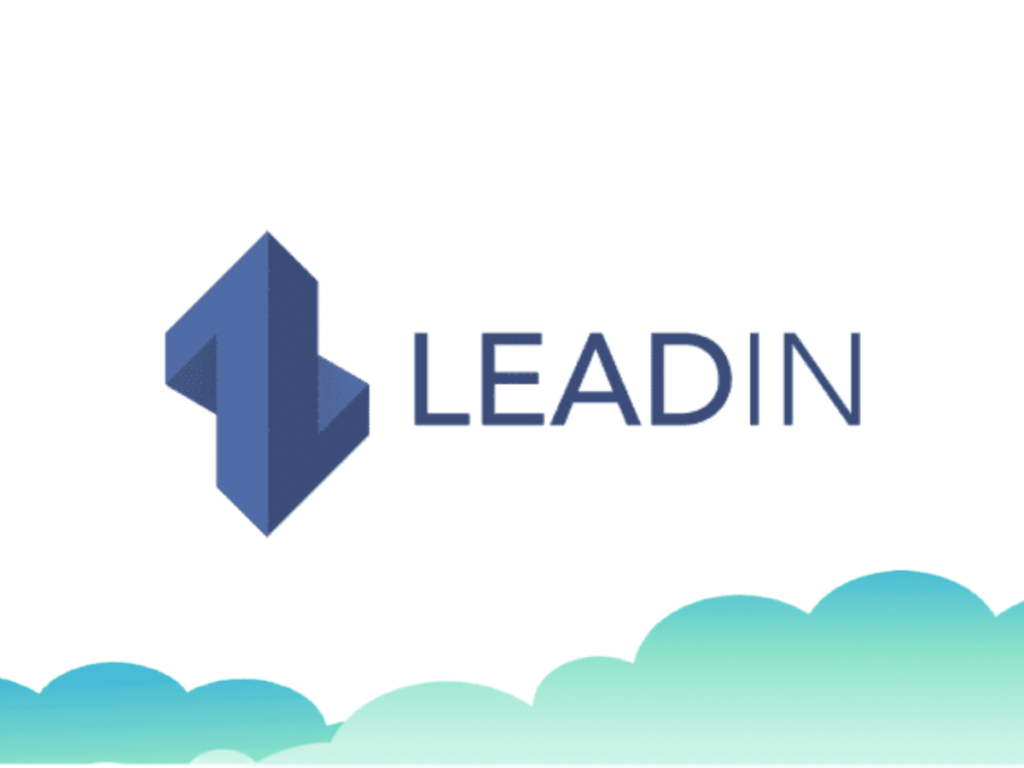Did you know that companies using a multi-channel prospecting strategy see a 287% increase in customer engagement (
source
) ?
Most of us live, work and shop online, and prospecting these days is no exception. Whether in sales or marketing, you target people out of the blue and try to get their attention, arrange more meetings and, ultimately, close more business via email and other communication channels.
Implementing a solid outreach strategy can help generate leads, turn them into satisfied customers and maintain relationships with them afterwards.
But how do you turn these cold targets into warm prospects and convert them into customers? It’s time to discover the best prospecting sequences. Our marketing team has done the research so you don’t have to, and we’re going to go over it:
- What is a prospecting sequence?
- 5 types of sequential messages
- 4 examples of prospecting sequences
- Best practices for prospecting sequences
We’ve got a lot to cover, so let’s get started!
What is an approach sequence and how does it work?
An outreach sequence is a planned series of actions and follow-ups carried out through one or more communication channels, aimed at connecting with prospects, customers or potential customers. The aim is to build relationships with prospects, arouse interest or prompt them to take a specific action.
For example, if you’re communicating by email, the first message will be an introductory one. If there is no response, you continue to send follow-up messages containing more information and value each time.
Depending on your target audience, their interests and preferences, and your overall strategy, you can create prospecting sequences using the following tools:
- social media (LinkedIn, Instagram, Twitter, etc.)
- telephone calls
- postal mails
The best prospecting sequences aim to add several points of contact with prospects and combine different channels. This means that each message in a sequence is personalized and tailored to respond to the prospect’s previous action in the sequence.
How do you create the best prospecting sequences?
The main characteristics of the best prospecting sequences are their structure and the strategy underpinning the intended communication. The aim is to gradually build up your prospecting sequence and engage your target audience.
Here are the main steps in the process:
- Determining objectives – Identify your prospecting objectives, find your target audience and understand their wishes, needs and challenges before developing a customized prospecting sequence.
- Sequence development and design – Create a series of messages and follow-ups using one or more channels that seamlessly guide them to action.
- Be sure to personalize messages based on previous searches and actions.
- Timing and frequency – Your main objective shouldn’t be too urgent or intrusive. So be sure to space the messages correctly and adjust the frequency accordingly.
- Execution – Contact your prospects manually. However, we advise you to automate your contact sequences for best results and efficiency. Customize and plan, then let the tool do the work for you, saving you hours of manual labor.
- Analysis and optimization – Once the sequence has been launched, your task is to track engagement and closely examine the indicators (open rate, click rate, response rate and conversion rate) to determine whether or not your sequence is working. Keep optimizing for best results.
Now that we know the basics of the prospecting process, let’s take a look at our tool
LeadIn
tool, so you can see first-hand how to create and automate the best prospecting sequences. 👇
Automate your prospecting sequences
How can you automate your prospecting sequences? Glad you asked.
These are LeadIn’s intelligent sequences, the first to be marketed. As LinkedIn automation and email prospecting software, we firmly believe in the multi-channel approach. That’s why you can combine these two channels in our sequence generator. Our intelligent sequences help you :
- Save up to 11 hours of manual labor per week.
- Organize three times as many meetings.
- Reach more quality prospects in less time.
- Increase response rates with our in-app hyper-personalization feature, and more.
What makes LeadIn’s intelligent sequences special is that you can combine the LinkedIn action and the email action with “if/else” conditions. This will help you reach your prospects in one way or another, while maximizing the points of contact with prospects. You can use all LeadIn’s main features within these sequences to help you reach your prospects in a more streamlined way. This includes :
- Email search and verification – Helps you find your prospects’ double-checked business emails without interrupting the prospecting flow, at no extra cost and without third-party tools.
- Image and GIF personalization – Add an extra visual touch to your information campaign, tailoring each message to your prospects’ interests and personal information. It also increases the response rate.
- A/B testing – You can test up to 5 text variants to determine which approach works best for each prospect.
Now let’s create a campaign together to see how it works. It’s as simple as 1, 2, 3…
Intelligent LeadIn sequences
- First, click on the “Create a new campaign” button.
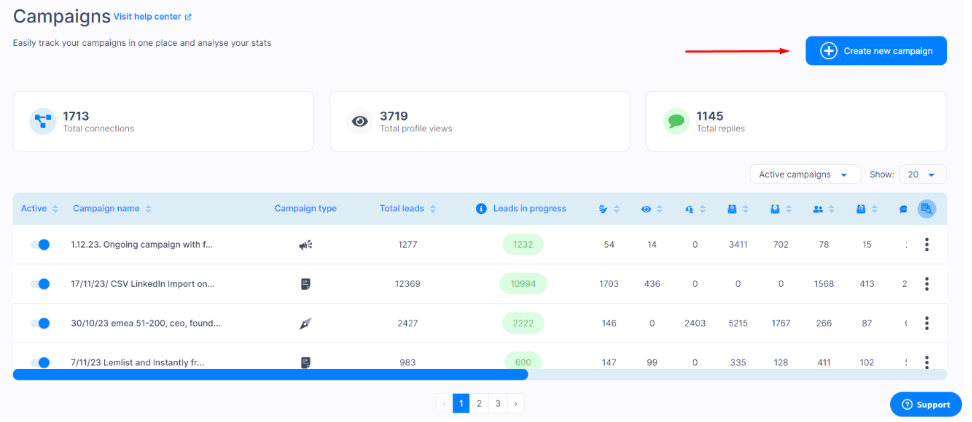
2. Second, choose a lead source. That’s where LeadIn imports all your leads.
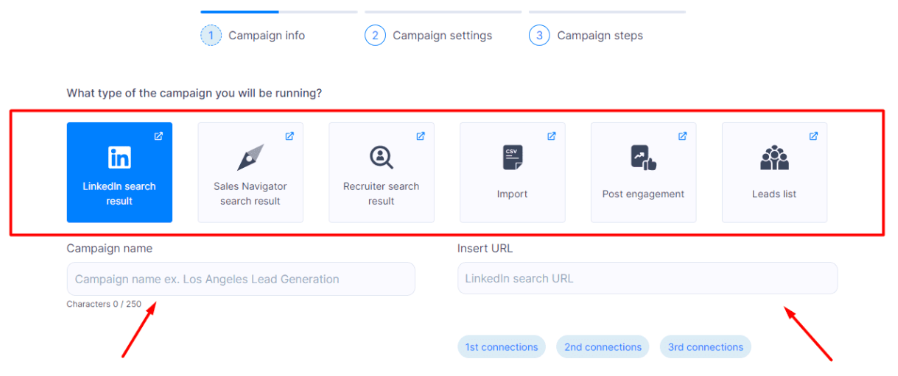
- Thirdly, set your campaign parameters and click on the “Create a sequence” button.
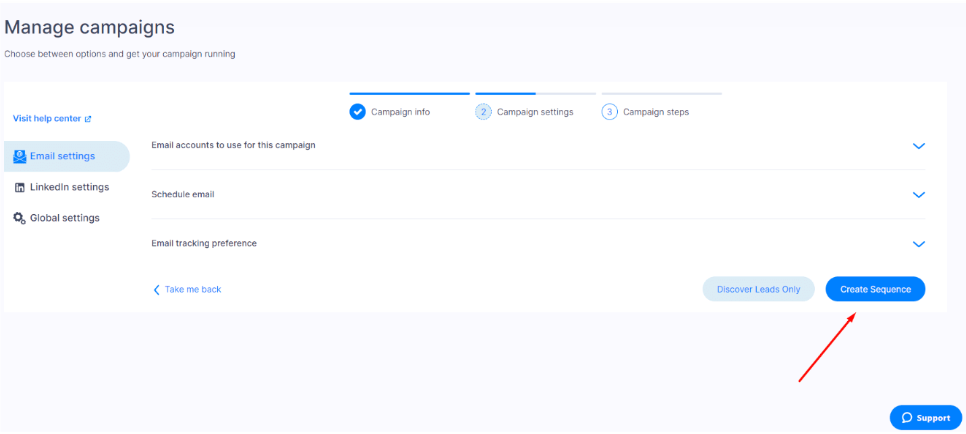
To create an intelligent prospecting sequence, drag and drop the desired actions and conditions to create a coherent prospecting flow. Here’s what a simple smart sequence looks like 👇
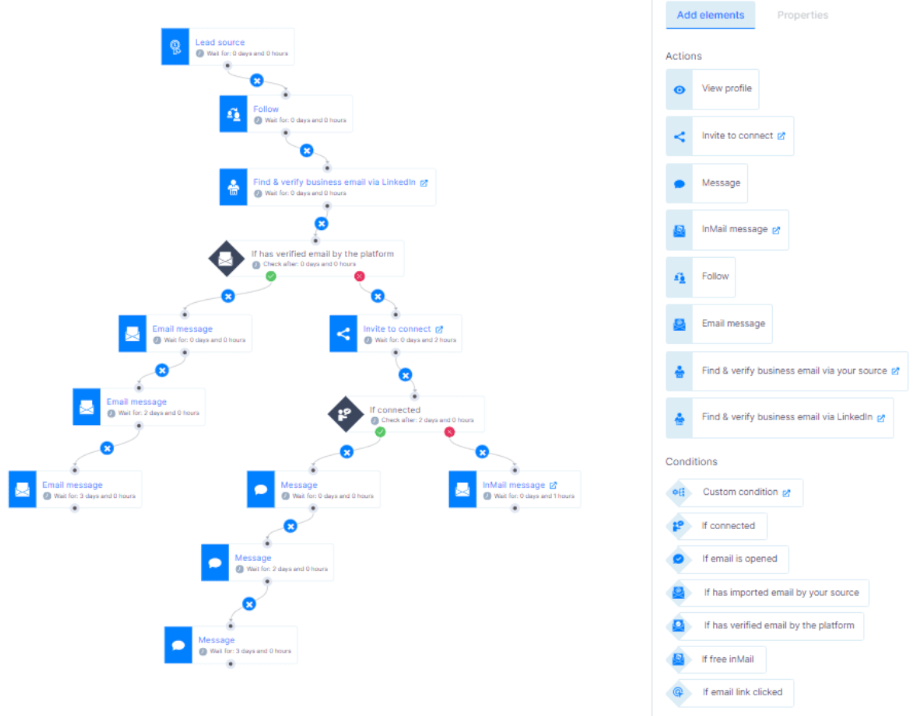
Now that you have a tool that does all this, and a little more, you’re one step closer to building one of the best prospecting sequences around. But before you start creating your prospecting flow, let’s take a look at the types of sequence messages and review some tried and tested examples of sequences.
5 sequential message types with examples
1. Educational messages
When addressing prospects who are not yet ready to buy, register or become customers, you can create and send educational messages. These messages are designed to help prospects familiarize themselves with your product/service and show them how your product can solve their problems. The aim is to build trust and encourage prospects to take the desired action.
Here is an example of an educational message on LinkedIn and by e-mail:
LinkedIn connection request
Hello {{firstName} },
Ever felt like you needed magic to solve {{painPoint}} at {{Company}}?
{{produit/service}} eliminates these difficulties.
You can :
- Increase {{mesure}} by {{nombre}}%.
- {{profit}}
We’re here to help you discover the magic.
Until then, good luck!

Subject: Would you like magic to solve your {{painpoint}} problem?
Hello {{firstName} },
Have you ever wished for a magic wand for {{painpoint}} at {{company name}}?
This is {{solution}} – not magic, but close.
Here’s what makes {{produit/Service}} magical:
- It eliminates {{painpoint}} and puts your team back on the road to success.
- Increases {{mesure}} by {{nombre}} %.
Are you curious? Let’s talk about it so you can voir magic in action
>> Receive brief information and case studies
>> Take a test drive with complete peace of mind, free of charge.
What’s your choice?
Cheers!
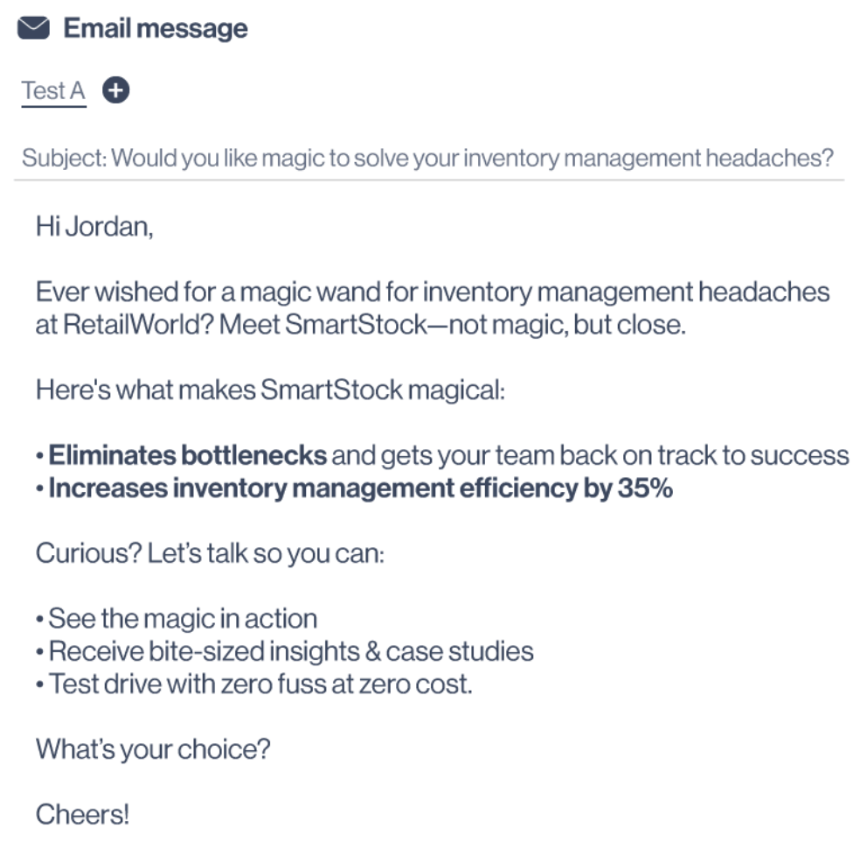
2. Messages that generate interest
Engagement messages are the most common in cold prospecting. Sequences built with engagement messages aim to elicit a reaction from your prospect. The aim of these messages is to maintain the prospect’s interest and gradually get them to take an interest in your product or service.
Here’s an example of a LinkedIn message and an Email that generate interest:
LinkedIn connection request
Hello {{firstName} },
Have you ever imagined turning {{challenge}} into an art form?
Here at {{produit/Service}}, we blend technology and creativity to create masterpieces.
Would you like to paint a brighter future together? Get connected!

Subject: Art meets {{challenge}} 🎨
Hello {{firstName} },
Imagine turning {{challenge}} into art. This is what we do with {{produit/Service}}. My name is {{votreNom}} and I blend technology and creativity to design solutions that are not only effective, but also inspiring.
We propose {{solution1}} and {{solution2}} to {{profit}}.
How about a quick chat to sketch out some possibilities?

3. Competitive analysis messages
If you’re planning to talk about the competition, the trick is to provide them with a simple competitor analysis and show them how they achieve these results. Then focus on how your product/service can help you achieve these benefits. Finally, end with a simple, clear CTA that leads the prospect to a specific action, such as making an appointment, booking a call, sending a demo link, etc.
Here’s an example of a competitor analysis message on LinkedIn and by email:
LinkedIn InMail message
Subject: Ready to outdo {{competing tool}}? 🚀
Hello {{firstName} },
Have you ever wondered why {{concurrence}} is the leader in {{industrie}}? Our audit reveals their key strategies:
{{Describe their approach to key strategy 1}}.
{{Describe their excellence in key strategy 2}}.
Here’s what you can do to win over them quickly:
{{Your offer – Task 1}} to improve your {{result}}.
{Your offer – Task 2}} to stimulate {{specific result}}.
Would you like to go beyond {{concurrence}}?
Let’s discuss the prospects for action in a brief call.
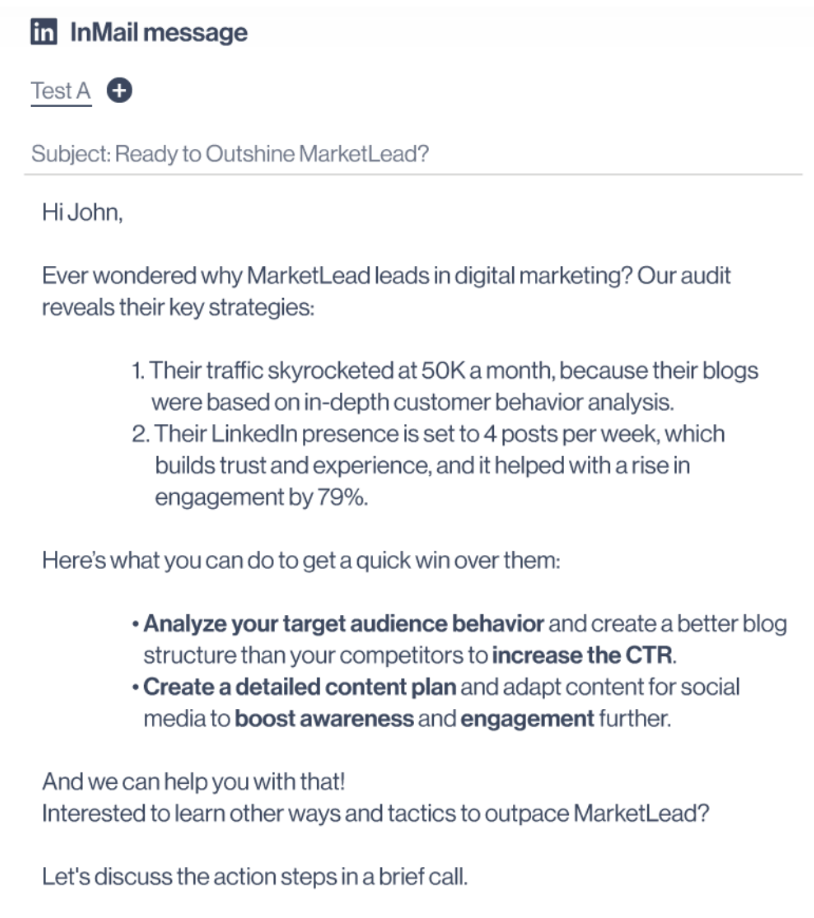
Subject: We cracked {{concurrence}} {{industrie}} 🚀
If you consider {{competitNom}} a competitor, then you’ll definitely want to take a look at this short audit.
{{Analyze competitors’ publicly available workflows or strategies and highlight what they do well}}
Proposal:
If you want to overtake your competitor’s name and gain a larger market share, you’ll need to :
{{fWhat you offer – task 1}}
{{fWhat you offer – task 2}}
And that’s exactly what we can do to help you!
If you want to stand out from your competitors, let’s arrange a quick telephone appointment and see how we can help you achieve this.
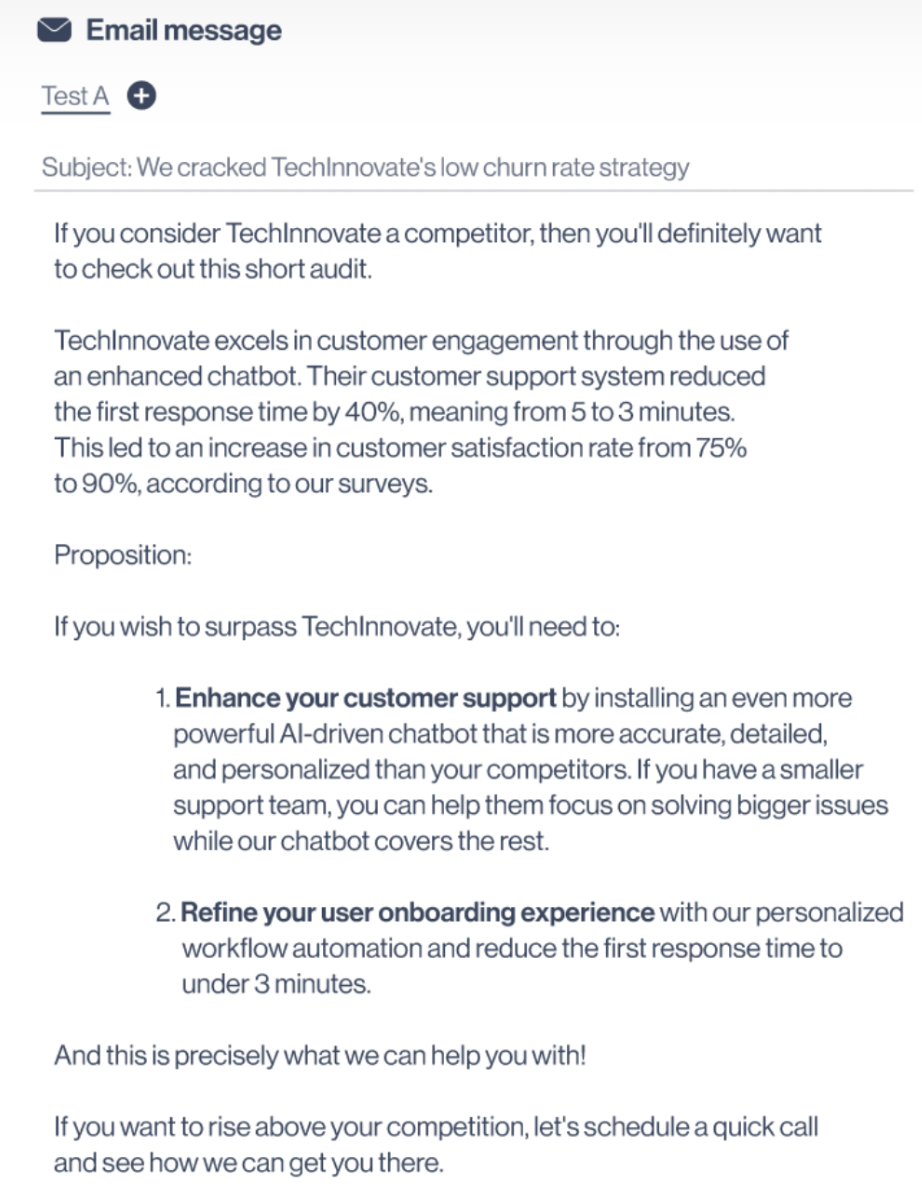
4. Follow-up messages
If your prospect hasn’t responded to your first message, you can simply follow up after the absence of a reply. Follow-up is an essential part of a prospecting sequence, and is necessary to gently remind your prospect of your existence and take them further along the buyer’s journey.
The aim is to keep in touch with your prospects and give them the right motivation to respond.
Here is an example of a follow-up message on LinkedIn and by email:
LinkedIn message
Hello {{firstName} },
I’m just following up on my previous post about how tackling {{challenge}} can feel like a steep climb. Imagine {{produit/service}} as your own personal helicopter, offering you a rapid ascent to the summit, effortlessly navigating around these obstacles.
Still curious about flying over challenges? Let’s plan a demonstration and start flying together.
We look forward to receiving your reply.
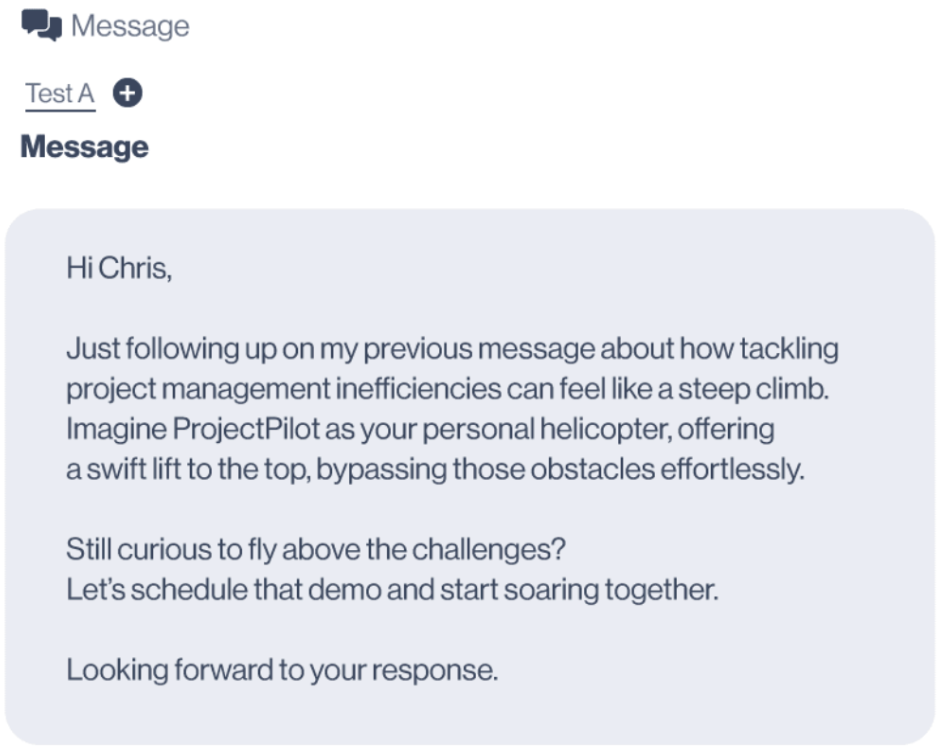
Subject: Ready to rise above {{challenge}}?
Hello {{firstName} },
Just going back to my previous post about transforming your approach to {{challenge}}. Think of {{produit/service}} as your helicopter on demand, ready to take you to the top without the climb.
Are you ready to explore how we can enhance your journey with a brief demonstration?
We can’t wait to see you rise!
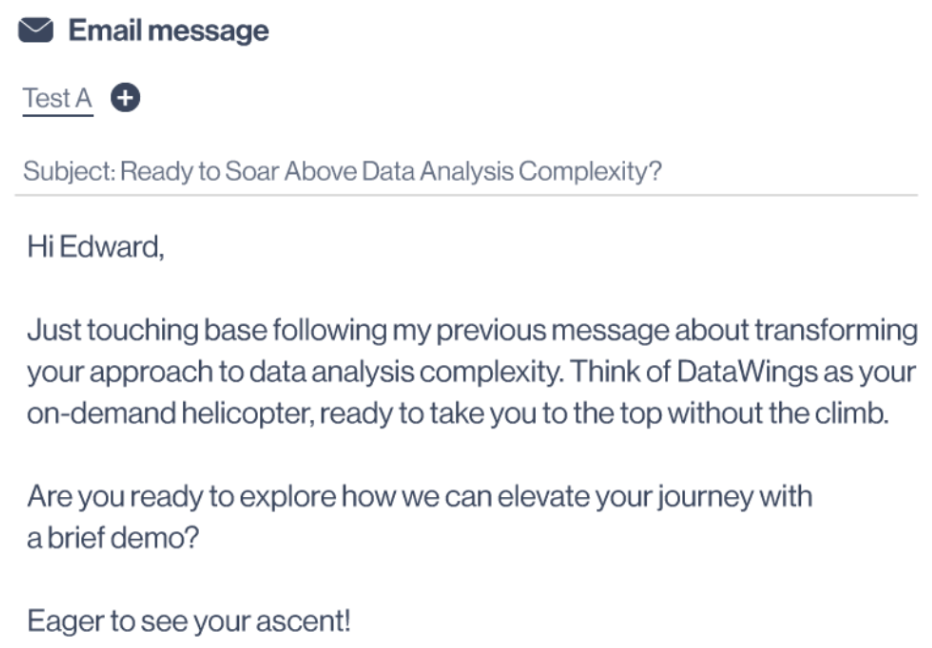
5. Re-engagement messages
Sometimes prospects lose interest, change their email address or want to come back to your conversation in a few months’ time. In these cases, you can do two things: in the first case, send a re-engagement message to restart the conversation.
In the second case, use LeadIn’s Find and Verify Professional Email function to obtain your prospect’s new email address, then send the re-engagement message. Practical, isn’t it?
Here is an example of a re-engagement message on LinkedIn and by email:
LinkedIn message
Hello {{firstName} },
It’s been a long time since I last chatted! 🕰️ {{produit/Service}} has evolved since our last conversation, revealing new ways to tackle {{challenge}}.
Curious about the updates? Let’s get back into the swing of things with a quick demonstration or discussion.
We look forward to seeing you again!

Subject: A lot has changed at {{produit/Service}}! Let’s get back in touch
Hello {{firstName} },
It’s been a long time coming! Since our last conversation, {{produit/Service}} has grown, offering new {{benefits}} for {{challenge}}.
Need a quick update? A quick discussion or demonstration might spark new ideas.
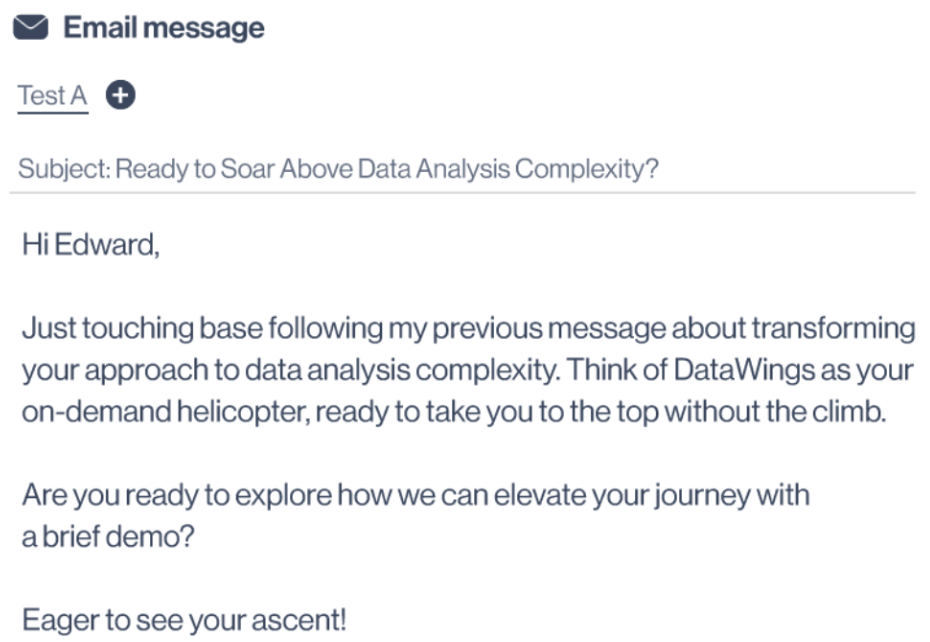
Best examples of prospecting sequences
Enough theory. Let’s move on to the social proof itself – a section in which we present our best prospecting sequences that have been tested and optimized to perfection to produce excellent prospecting results.
Since we believe that multi-channel prospecting is the way forward, we’re going to introduce you to 4 of our sequence models, which are sure to produce results. All you need to know about them is that our sales manager, Maxime, has closed over 50 meetings using them!
1. Reach prospects who have reacted to a LinkedIn post by an industry expert.
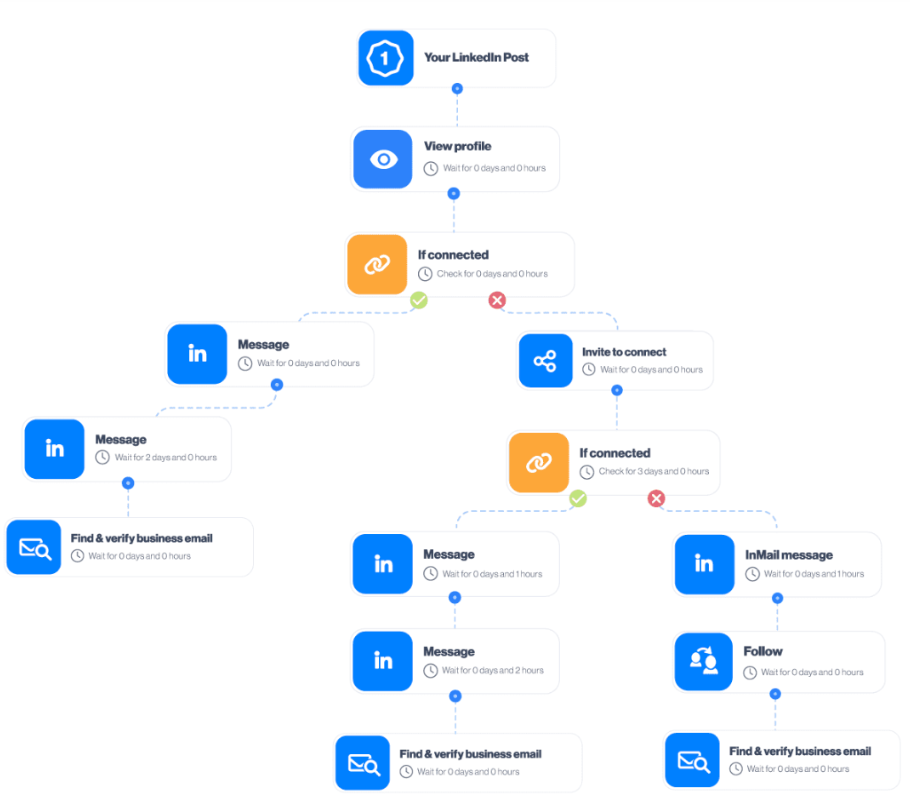
In this prospecting sequence, we used a combination of educational and conversion messages. Let’s look at the statistics:
- 76% acceptance rate
- 35% response rate
- 85% open rate
This sequence works because we’ve used both LinkedIn and e-mail, and we’ve exhausted all communication channels to reach our prospects in every case. If you’re trying to reach people who have reacted to a message posted on LinkedIn, it’s safe to assume that you’re probably not in touch with them.
We use InMails because, in our experience, people generally respond better to them. If you can send them for free, without spending your InMail credit, that’s even better. The “Find and verify email address” function allows you to reach prospects by email if they are not as responsive on LinkedIn. Email is an important part of the contact process. In fact, 77% of B2B buyers prefer to be contacted by e-mail.
2. Target members of specific groups
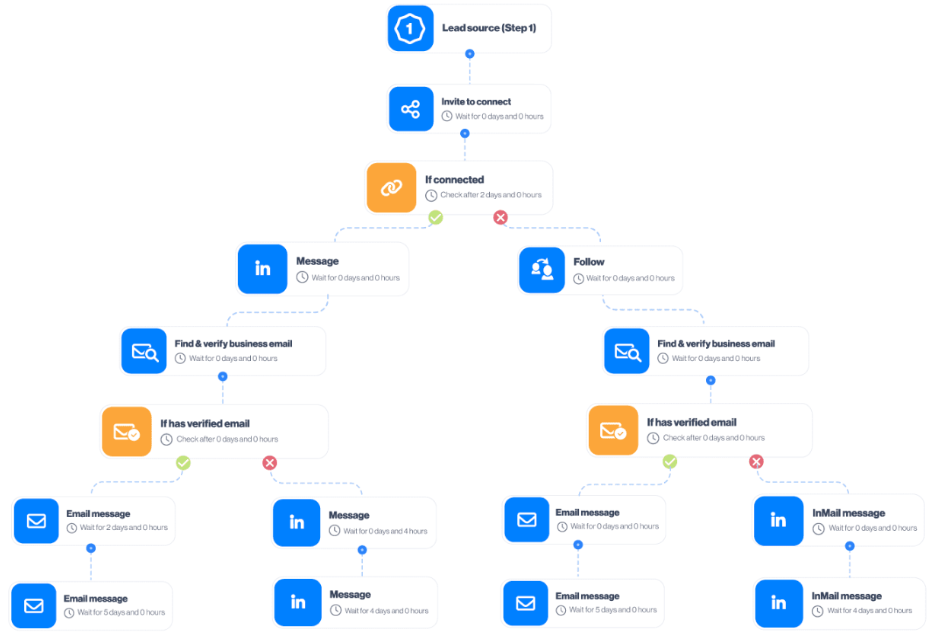
This particular sequence enabled us to recruit many new users, and our sales team was able to book more appointments than usual. We used tracking, engagement and conversion messages, as well as both communication channels. Here are the results:
- 53% acceptance rate
- 27% response rate
- 73% open rate
Targeting members of specific groups means we’re looking for decision-makers, and we want to reach them faster. To do this, you can use the search results in the Sales Browser with the Group Members filter. In the sequence, we use the If Connected condition for LinkedIn to cover all the leads in our lead source. Then, if they don’t respond on LinkedIn, we find their double-checked email address and try to reach them there.
3. Contact people who have visited your website

Marketers, look! A sequence that targets people who have stumbled across your website and need a little nudge to take action. If you use a third-party tool on your website that can tell you which company has visited your website, you can easily find these people on LinkedIn and contact them. Let’s get to the heart of the matter:
- 43% acceptance rate
- 23% response rate
- 71% open rate
In this sequence, our sales team used educational and engagement messages to generate additional interest and give social proof and more information to prospects already interested in your product/service. We’ve also opted for a multi-channel approach that works every time!
4. Email-based educational sequence
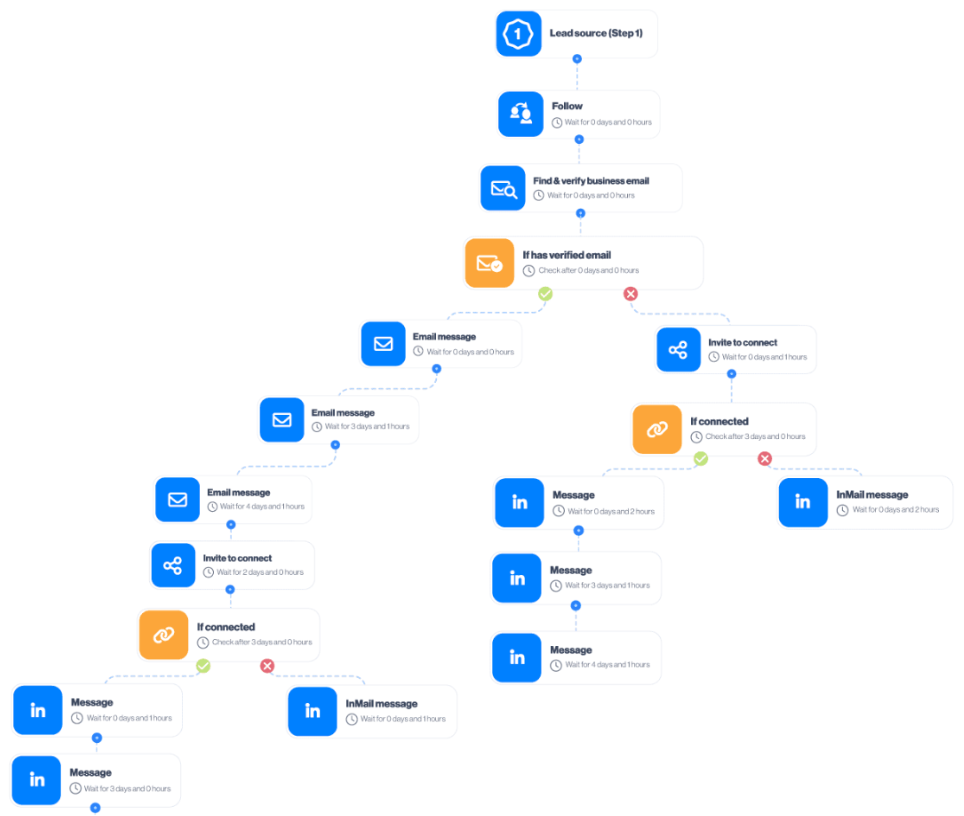
This sequence is part of our free trial period and is also available to all LeadIn users. Our sales team has created this template to show you how to engage your target audience for your product/service with a carefully crafted message and tone.
We used educational and engagement types of messaging, focusing on email, but also using LinkedIn as another communication channel. Here are the statistics:
- 63% acceptance rate
- 41% response rate
To view the message templates, you need to register for a
14-day free trial
with LeadIn.
Prospecting sequences: Best practices
After testing and experimenting with different approaches, we’ve compiled a list of best practices that we always keep in mind when creating prospecting sequences. Let our experience be your guide to creating the best prospecting sequences. 👇
Use a multi-channel approach
What if we told you that 58% of people check their e-mail first, and 14% their social networks? This statistic simply proves that using two or more communication channels is a must when it comes to prospecting. We’ve said it once and we’ll say it again: a multi-channel approach is the best way to achieve higher response rates and faster overall results.
Automate prospecting
Companies that automate their prospecting campaigns can improve their response rate by 250%. If your goal is to reach a wider audience, or if you simply want to save time on manual prospecting and concentrate on building and developing relationships with prospects, prospecting automation is the best solution for you. What’s more, you’ll get faster, higher-quality results.
Add an eye-catching subject line
Did you know that creating a catchy subject line is directly linked to a higher open rate? A good subject line combined with good header text is what helps prospects decide whether to open and read your email.
Our best advice is to keep it short, simple and around 55-60 characters (less than 30 characters if you want to stand out in phone inboxes). When it comes to emojis, our research indicates that you should use one emoji per subject line. Also, don’t use emojis in place of words to avoid confusion.
Customization
These days, if you want to stand out online, you need to personalize your approach. If you create tailor-made messages, emails and follow-ups, and add visual elements (customizing LeadIn images and GIFs), you’re bound to get a higher response rate. In fact, up to 63%, to be exact.
Be brief
No prospect wants to read a huge message with a standardized approach. If you want to create an effective prospecting sequence, you need to be concise and to the point. Otherwise, your message will get lost in your prospects’ inboxes without a trace.
However, if you don’t get a positive response on the first try, creating a strong follow-up message after a lack of response can increase your chances of success. In this case, the same rules apply: keep your messages short, but add value and personalized elements to each message.
Relevant value proposition
Every message you write and send as part of an outreach sequence must bring value to your prospect. Once you’ve gathered information about your target audience, make sure you find relevant contact points and distribute them evenly throughout your sequence. Each message must add value. You need to show your prospects that your offer is exactly what they need.
Pro tip: Maxime, our sales manager, says that sales e-mails are never about you. It’s about the prospect and their problems, which can only be solved with your solution and your solution’s solution.
Include social proof
When it comes to prospecting, it’s all about numbers. This means that the addition of certain pieces of information, results or proven statistics will attract more interest from prospects. Link a case study or add 1 or 2 sentences to your prospecting message to add social proof to your prospecting.
Call to action (CTA)
Our sales team told us to tell you that when creating calls to action, you need to think about creating the perfect environment for your prospect to take the desired action. Naturally, your entire message must culminate in this moment of conclusion, known as the CTA. To avoid confusion, use a single call to action instead of several. Keep the prospect’s attention throughout the message, then add the CTA.
In our experience, a good CTA should be
- simple
- direct
- clear
Determine the sequence schedule
In prospecting, as in life, timing is everything. Determining the length and spacing of messages is just as important as the messages themselves. If you send messages too often, they’ll be considered spam, but the sequence won’t be successful if you don’t contact them often enough. It’s all a question of balance. So be sure to space out your prospecting messages by 2 to 5 working days, which is the norm.
A/B testing for optimization
Not sure if your content is good enough? Don’t worry. A/B testing, also known as split testing, is here to help you constantly improve your campaign. We advise you to integrate frequent A/B testing into your prospecting sequence strategy to achieve better results faster. Get into the habit of always looking for better ways to reach your prospects.
Ready to put these best approach sequences to work?
Of course you are! Now that we’ve covered everything you need to know about creating the best contact sequences, it’s safe to say that if you follow these instructions, you’re well on your way to successful contactmaking efforts. So let’s review what we’ve learned so far:
- Using automation tools for prospecting saves time, improves results and allows you to devote more time to developing better sequences and maintaining relationships with prospects.
- Using a multi-channel approach, i.e. at least two communication channels, is the key to faster, more effective prospecting.
- Personalization is the key to a higher response rate.
- Eye-catching subject lines are directly linked to higher open rates.
- A clear CTA improves click-through and response rates.
- Strategic timing of prospecting sequences improves overall results and affects all relevant indicators.
- By combining relevant content with personalized communication, we build trust and interest.
What next? All you need is the right automation tool to help you create the best approach sequences and build successful campaigns that deliver stunning results. This is where LeadIn comes to the rescue. You can register for free, start your 14-day free trial and start creating the best prospecting sequences ever! Let the prospecting begin!






